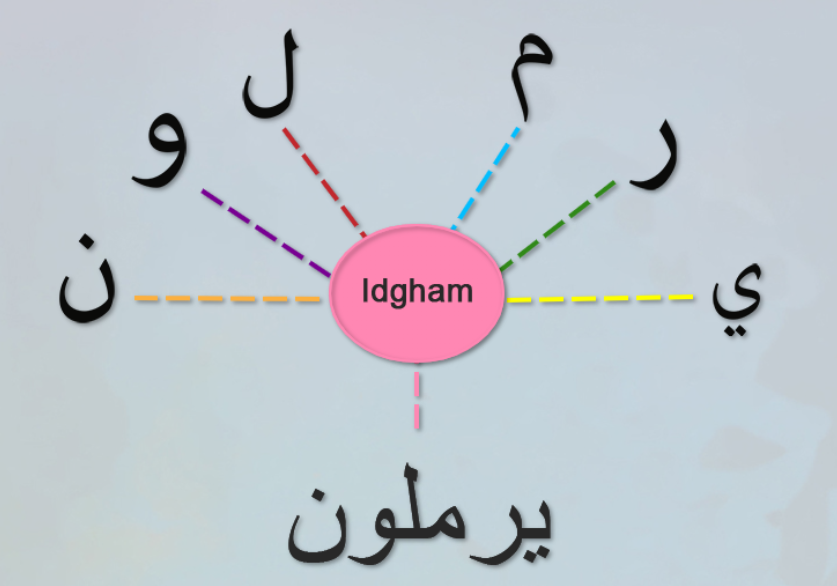Tajweed refers to the rules for the right pronunciation and recitation of the Holy Quran, which include the utterance and sounds of the letters, opening and hiding them, and more. Following up on our recent articles on Tajweed rules such as the Meem Sakinah rules with examples as well as the rules of Noon Sakinah and Tanween, it is now time to clarify the last topic more to master it.
In Tajweed, there are four rules on what happens when a letter accompanied by Noon Sakinah (نْ) or Tanween is followed by another letter. In both of the rules, Idgham occurs. This post entirely focuses on this branch of Tajweed, i.e., Idgham. To learn what is Idgham in Tajweed and its types in detail, continue reading this post.
Table of Contents
What Is Idgham in Tajweed
Idgham meaning in English is adding one thing into another. It happens when we categorize objects having similar characteristics since it is easier for us, in the end, to get what we need. In the same way, it is easier for the tongue to join two letters and produce the sound of the one with the more dominant characteristic. This is called Idgham.
If you have no prior knowledge about Tajweed and other reading rules, it is advisable to enroll in our Noorani Qaida Online Course to learn how to read the Quran before learning Noon Sakinah and Tanween rules, such as Idgham.
Also, check this blog for some expert tips to learn Noorani Qaida effectively and how to master it!
Idgham Definition
When it comes to Quran recitation rules, this term means to merge. Idgham in Tajweed means joining a non-vowel with a vowel so that the two letters become one letter of the second type. Idgham occurs if after Noon Sakinah or Tanween there appear any of the following letters:
- ي
- ر
- م
- ل
- و
- ن

These are the letters of Idgham and can be memorized in the form of يَرْمَلُون. As another replacement, an easier phrase that can be used is لر ينمو. The reason to memorize this phrase is due to the fact that this phrase divides the letters of Idgham into letters that will be used for Idgham with Ghunnah (ي ن م و) and without Ghunnah (ل ر).
But what is Idgham in Tajweed? If after Noon Sakinah or Tanween comes any of the Idgham letters, Noon Sakinah or Tanween will merge into the letter. The stress will be on the succeeding letter because of the Shadd sign.
To make what is the concept of Idgham clearer, Idgham only occurs when two words are present – the first word will end with a Noon Sakinah or Tanween, and the second word will begin with one of the Idgham letters.
Types of Idgham in Tajweed
Now that you have learned what is Idgham in Tajweed and you know the letters of it, let’s focus on its types with examples. You may ask: How many types of Idghaam are there? And the answer is as follows:
- Idgham with Ghunnah
- Idgham without Ghunnah
Idgham with Ghunnah

The first type is Idgham with nasalization, and nasalization (Ghunnah) is a sound that comes out from the nose. This type applies with certain letters of the Idgham letters, which include (ي, ن, م, و) or يَنْمُو. They are called letters of Idgham with Ghunnah. If any letter appears after Noon Sakinah or Tanween, the Noon Sakinah or Tanween sound will be dropped, and the letter before the Noon Sakinah or the letter having Tanween will merge with the Idgham letter.
In addition, Ghunnah will occur, in which the reciter will stress on the joining that takes place. An example of this is وَجَعَلْنَا سِرَاجًا وَهَّاجًا (An-Naba:13). Here, the letter (و – waw) appears after the Tanween, and its sound drops and the letter Jeem (جً) merges with (و). The letter Alif (ا) gets ignored in this instance.
Another instance is جَزَاءً مِّن رَّبِّكَ عَطَاءً حِسَابًا (An-Naba:36). Here, the letter Hamza (ءً) has a Tanween and letter following it is (مِ – Meem). So, Idgham with Ghunnah occurs. In this case, the reciter applies Ghunnah by emphasizing the two highlighted letters by decreasing the normal sound caused by the Tanween and joining Hamza with Meem.
Among Idgham examples is وَمِنَ النَّاسِ مَنْ يَقُولُ آمَنَّا بِاللَّـهِ وَبِالْيَوْمِ الْآخِرِ وَمَا هُمْ بِمُؤْمِنِينَ (Al-Baqarah:8). In this example, after the Noon Sakinah appears the (يَ), which is the letter of Idgham with Ghunnah. Consequently, the reciter stresses the joining of Meen with Yaa as the Noon Sakin is dropped and the sound produced is Mayyyy.
Some Other Examples of Idgham with Ghunnah:
- أَوْ كَصَيِّبٍ مِنَ السَّمَاءِ فِيهِ ظُلُمَاتٌ وَرَعْدٌ وَبَرْقٌ يَجْعَلُونَ أَصَابِعَهُمْ فِي آذَانِهِمْ مِنَ الصَّوَاعِقِ حَذَرَ الْمَوْتِ ۚوَاللَّـهُ مُحِيطٌ بِالْكَافِرِينَ (Al-Baqarah:19)
- إِذْ أَوَى الْفِتْيَةُ إِلَى الْكَهْفِ فَقَالُوا رَبَّنَا آتِنَا مِنْ لَدُنْكَ رَحْمَةً وَهَيِّئْ لَنَا مِنْ أَمْرِنَا رَشَدًا (Al-Kahf:10)
Idgham without Ghunnah

There are two letters of Idgham without Ghunnah: Laam (ل) and Raa (ر). Whenever any of these letters come before Noon Sakinah, then Noon Sakinah would be dropped, and the letter coming after Noon Sakinah would join with either Laam or Raa. In this type, in which either the Laam or Raa follow a Tanween, the reciter will not produce the sound NNNNN that arises because of the presence of Tanween.
Examples of Idghaam without Ghunnah in the Quran:
- فَإِنِ انْتَهَوْا فَإِنَّ اللَّـهَ غَفُورٌ رَحِيمٌ (Al-Baqarah:192)
Since Tanween is followed by Raa, the reciter will drop the Tanween and read it with a Dummah. Instead of pronouncing it as Ghafoorun Raheem, it will be joined and pronounced as Ghafoorur Raheem. But, this merge will not be dwelled upon as Ghunnah does not occur.
- أُولَـٰئِكَ عَلَىٰ هُدًى مِنْ رَبِّهِمْ ۖ وَأُولَـٰئِكَ هُمُ الْمُفْلِحُونَ (Al-Baqarah:5)
Here, the Noon Sakinah is followed by Raa and will be dropped completely. The letter before Meem will merge with Raa and is pronounced as Mir-Rabbihim instead of Min Rabbihim.
- وَمَنْ أَضَلُّ مِمَّنْ يَدْعُو مِنْ دُونِ اللَّـهِ مَنْ لَا يَسْتَجِيبُ لَهُ إِلَىٰ يَوْمِ الْقِيَامَةِ وَهُمْ عَنْ دُعَائِهِمْ غَافِلُونَ (Al-Ahqaf:5)
In this verse, the Noon Saakin is dropped as it is followed by Laam. It will be pronounced Mallaa, instead of Man-Laa.
Conclusion
To learn the Quran with Tajweed rules and make significant progress, practicing all these rules is essential. At Riwaq Al Quran, an online Tajweed course is offered to help you learn even more about what is Idgham in Tajweed.
In our Learn Quran with Tajweed Online course, we have made a great effort to make learning Tajweed and Idgham rules quite easier for online learners. We try our best to simplify this task using different examples, activities, and videos. Visit our website to get yourself or your kids enrolled in our Tajweed course and have 2 free trials!
[ictabs alias=”best-online-tajweed-course”]



































